Frost and Heat
- Bees, Birding, Compost, Frost and Heat, Fungus and Mushrooms, Gardening adventures, Hugelkultur, Irrigation and Watering, Microbes and Fungi, Natives, Other Insects, Perennial vegetables, Permaculture and Edible Forest Gardening Adventures, Planting, Predators, Quail, Rain Catching, Recycling and Repurposing, Reptiles and Amphibians, Seeds, Soil, Water, Water Saving, Worms
What a Difference Mulch Makes
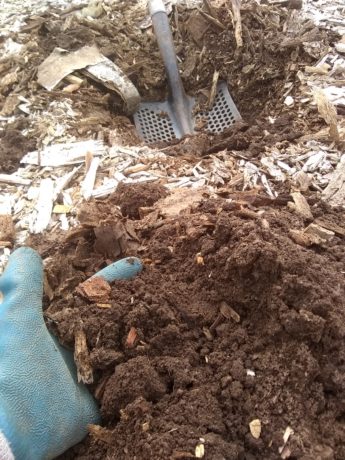 Two years ago friend sheet-mulched her very hard, dry dirt yard using cardboard and newspaper topped with very large chunk free wood chips. Last year into this were planted a scattering of California native plants. Most of them have thrived, even surviving a frost and many 100F + days. These have been minimally watered. This week in March, after very low seasonal rainfall, we set off to plant more natives. What we found under the mulch was amazing. That light brown dirt was now moist, worm-filled soil. Under what was left of the cardboard were beautiful fungal hyphae breaking down the under layer of bark chunks into a fine surface compost. The shovel slide through the newspaper and into the ground making for very easy digging.
Two years ago friend sheet-mulched her very hard, dry dirt yard using cardboard and newspaper topped with very large chunk free wood chips. Last year into this were planted a scattering of California native plants. Most of them have thrived, even surviving a frost and many 100F + days. These have been minimally watered. This week in March, after very low seasonal rainfall, we set off to plant more natives. What we found under the mulch was amazing. That light brown dirt was now moist, worm-filled soil. Under what was left of the cardboard were beautiful fungal hyphae breaking down the under layer of bark chunks into a fine surface compost. The shovel slide through the newspaper and into the ground making for very easy digging. 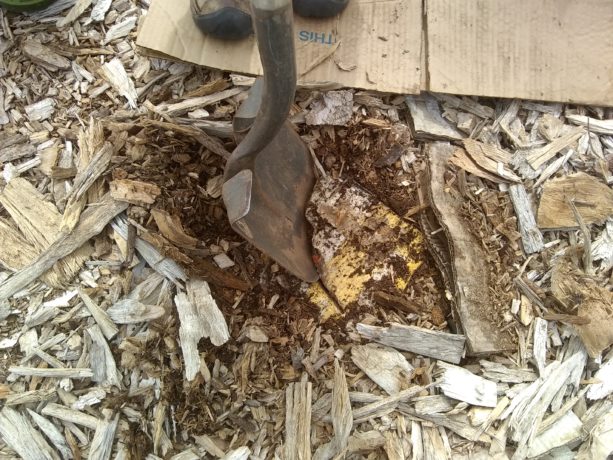 The soil smelled good and felt alive.
The soil smelled good and felt alive.Then we wanted to enlarge the planting area past the mulched area, and it was as if we were digging on another property. The shovel barely entered the dirt, and then hit hardpan within an inch of the surface. We had to chop and scrape holes to plant in. Once we did, we heavily sheet mulched around the plants.
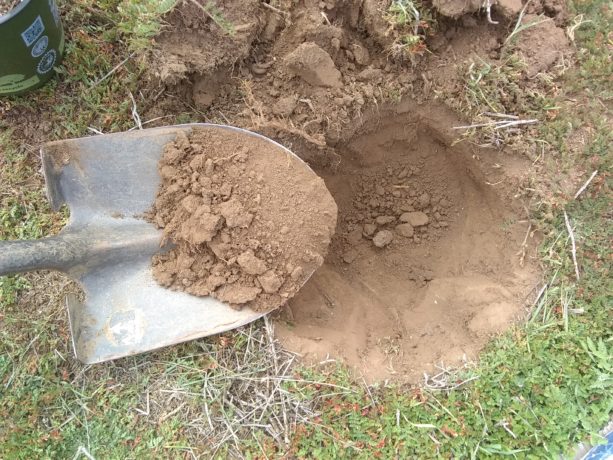
 Both of these areas, separated by a foot, have had the same rainfall and temperatures, but the mere existence of a thick layer of sheet mulch caused moisture and coolness to be retained, caused protection from hard rain, frost, high heat and dryness, compaction and wind. Just this easy combination of waste materials – wood chips and cardboard – made an incredible change in the soil structure and water retention.
Both of these areas, separated by a foot, have had the same rainfall and temperatures, but the mere existence of a thick layer of sheet mulch caused moisture and coolness to be retained, caused protection from hard rain, frost, high heat and dryness, compaction and wind. Just this easy combination of waste materials – wood chips and cardboard – made an incredible change in the soil structure and water retention.Last summer when the outside temperature was in the 90’s we dug into a pile of bark chips. On the top the wood was almost hot. Three inches down, it was cool and moist even though it hadn’t rained for months. A difference of night and day. This summer I’ll obtain a compost thermometer and take readings.
Leaving the soil bare is like going out in all weather unclothed. Your skin will burn and you’ll become dehydrated in summer; you’ll freeze and also become dehydrated in the cold. In heavy rain and hail you will try to protect yourself by becoming as small a target as possible. Although the soil isn’t cowering, it is being pounded down and de-oxygenated under the onslaught of weather. With no air in the topsoil water runs off rather than sinks in. Soil bakes and there is no microbial life in the desert of the uncovered topsoil. The soil freezes and frosts, and microbes are killed; the moisture in the soil evaporating with the coming of spring. All of this damage is preventable by the application of several layers of mulch, or sheet mulch. You wouldn’t think of being outside for a long time in harsh weather without clothing, so protect your soil the way nature intends, with a carpet of organic matter.
The cardboard had gone on top of weeds. No additives were used in planting, such as gypsum, fertilizer or compost. Watering is done on an as-needed basis with a hose. I am always thrilled and awe-struck when, over and over again, I see proof of what simple soil conservation efforts have on soil building.
California poppies seeds had been planted in the planting holes the year before, and their seeds have rooted in the bark mulch. Their roots will hold the mulch together and also help change it into soil, as poppies are colonizers helping repair disturbed soil. For the price of a packet of seeds, our friend now has the beginnings of a wildflower meadow filling out the spaces between native flowering plants.
Good soil begins the food chain, beginning from what science can so far tell from microscopic mycrobes and ending in this property at least perhaps at the nesting red tailed hawk in the nearest tree, or perhaps the largest local predator, the coyote. Meanwhile the butterflies and other native insects, and all the song birds, will be on display for our friend’s enjoyment.
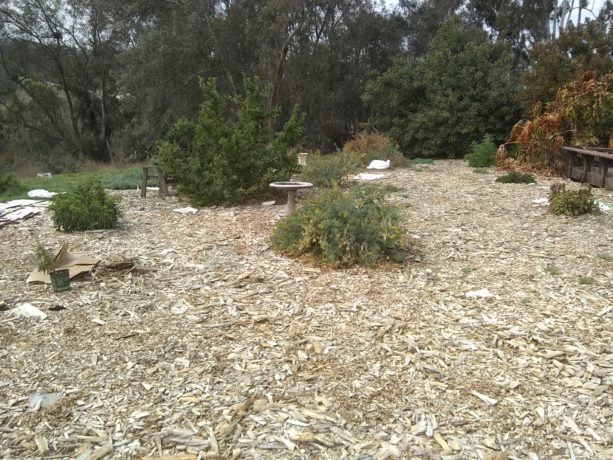
The sheet mulching will continue on over the slope, and as we plant we mix in pieces of old wood, we plant in shallow depressions in the ground to capture moisture and coolness, we dig a small fishscale swale above the plant to capture flowing water, and we sheet mulch heavily. It will be fascinating to keep checking that poor dirt as it regains microbial and fungal life simply through the protection of sheet mulch.
- Animals, Bees, Building and Landscaping, Compost, Frost and Heat, Fungus and Mushrooms, Gardening adventures, Giving, Health, Heirloom Plants, Houses, Hugelkultur, Irrigation and Watering, Microbes and Fungi, Natives, Other Insects, Perennial vegetables, Permaculture and Edible Forest Gardening Adventures, Planting, Rain Catching, Recycling and Repurposing, Reptiles and Amphibians, Seeds, Soil, Water, Water Saving, Worms
Inspiring Successful Earth-saving Projects
We can help the planet re-vegetate and reverse climate change. Here are three large projects that have had success and one which is still in the making because it is so vast. Watch these and be inspired, be hopeful, and plant native trees where you live:
Africa’s Great Green Wall:
earthrise – The Great Green Wall
Subscribe to our channel http://bit.ly/AJSubscribeThe Sahara is creeping into the verdant southern Africa. To counter desertification, the Community of Sahel…
China’s Loess Plateau:
Agroecology in China: 300% Increase on 8.6 Million Acres – Loess Plateau
Go to https://FoodAbundance.com to join the Food Abundance movement.Excerpts from Hope in a Changing Climate (http://www.open.edu/openlearn/whats-on/ou-on-th…
Jordan’s Greening the Desert:
https://www.youtube.com/watch?v=sohI6vnWZmk
- Bees, Compost, Frost and Heat, Fungus and Mushrooms, Gardening adventures, Hugelkultur, Irrigation and Watering, Microbes and Fungi, Natives, Other Insects, Permaculture and Edible Forest Gardening Adventures, Rain Catching, Recycling and Repurposing, Reptiles and Amphibians, Seeds, Soil, Water, Water Saving, Worms
Shade
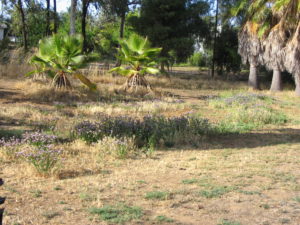
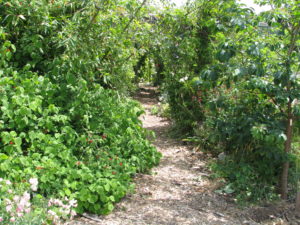 In drylands there is a noticeable lack of trees. This situation is kind of a Catch-22. The hotter and drier it is, the less water there is in the ground to provide for plants that can attain height, and the more the leaves of the existing trees must adapt (become smaller) to prevent transpiration and sunburn. Yet the very lack of trees and their extensive root systems, and the shade and habitat they create, and the transpiration that allows humidity to keep the air moist for pollen to survive, is one of the causes of desertification.
In drylands there is a noticeable lack of trees. This situation is kind of a Catch-22. The hotter and drier it is, the less water there is in the ground to provide for plants that can attain height, and the more the leaves of the existing trees must adapt (become smaller) to prevent transpiration and sunburn. Yet the very lack of trees and their extensive root systems, and the shade and habitat they create, and the transpiration that allows humidity to keep the air moist for pollen to survive, is one of the causes of desertification.So how do we stop this cycle?
First, work on a manageable area. If you have a large property, then start on the area closest to your home or where you need water the most, or where water settles. As in the Annie Lamont title, Bird by Bird, you work on a piece a little at a time.
- Put in earthworks to harvest rainwater. Simple swales or rain catchment basins, perpendicular to the water flow and on contour with your property, will harvest hundreds of gallons of water each rain. You can do them with tractors, you can do them with shovels, you can do small ones with trowels above small plants. Just do them.
- Bury organic matter: hugelkultur. Do you have old wood laying around? Palm trees that are growing and being a fire hazard? Old untreated lumber full of nails? Branches? All of this can be layered into the ground. Bury organic matter downhill from your swales. If you cannot bury, then pound sticks vertically into the ground. The important thing is that you are adding organic material back into your depleted soil. It will hold rainwater, it will activate soil microbes and fungi, it will open oxygen and nutrient channels, it will sequester carbon and make it available to the plants. Our soil is mostly just dead dirt. By layering organic material with dirt you are doing what nature does, but at an accelerated pace.
 If your soil is unmanageable, or you can’t dig, then layer on top of the soil. Its called, among other things, lasagne gardening. Lay out newspaper, top it with fresh grass clippings or other greens, top that with dried grass clippings, dried leaves or other ‘brown’ materials, and depending upon what you want to plant in this, you can top it with mulch or with a layer of good compost and then mulch. Then plant in it! You create soil on top of the ground.
If your soil is unmanageable, or you can’t dig, then layer on top of the soil. Its called, among other things, lasagne gardening. Lay out newspaper, top it with fresh grass clippings or other greens, top that with dried grass clippings, dried leaves or other ‘brown’ materials, and depending upon what you want to plant in this, you can top it with mulch or with a layer of good compost and then mulch. Then plant in it! You create soil on top of the ground. - Mulch and sheet mulch! Protect your soil from the heat and wind, and from pounding rain. A thin layer of bark will actually heat up and accelerate the evaporation process: add several inches of mulch to the ground. Better yet, sheet mulch by laying cardboard and/or newspaper directly on top of the weeds and layering an inch or more of mulch on top.
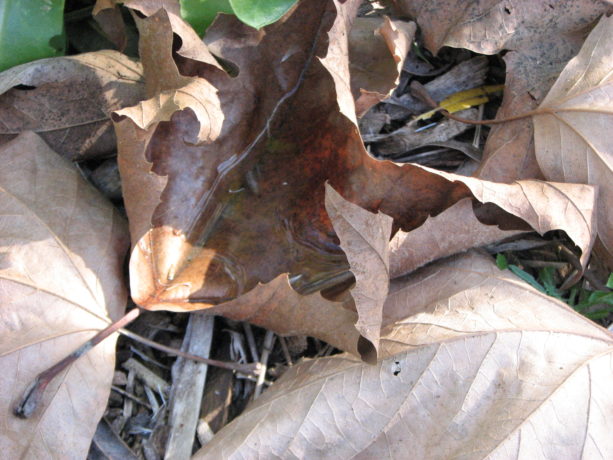 This can be free mulch from landscapers, old weeds, grass clippings, animal bedding, softwood cuttings… just cover the soil to keep it moist and protected. Thick mulching alone will help keep some humidity in the air and begin soil processes, as well as reduce evaporation by reflected heat that comes from bare earth or gravel.
This can be free mulch from landscapers, old weeds, grass clippings, animal bedding, softwood cuttings… just cover the soil to keep it moist and protected. Thick mulching alone will help keep some humidity in the air and begin soil processes, as well as reduce evaporation by reflected heat that comes from bare earth or gravel. - Plant native plants. They thrive in our soil. Grow trees that filter the sun and don’t like a lot of water, such as palo verde, or those that take minimal additional water such as desert willow, California redbud, valley oak, or others. Grow tall bushes such as toyon, lemonadeberry, sugarbush, quailbush, ceanothus
 or others. Use these wonderful plants to invite in birds,butterflies, lizards and other wildlife that will begin pollination and help activate the soil.
or others. Use these wonderful plants to invite in birds,butterflies, lizards and other wildlife that will begin pollination and help activate the soil. - Design your garden for what you want to grow besides natives. Fruit trees? Vegetables? Ornamentals? They can be arranged in your mulched area in guilds to grow cooperatively.
- Grow shade. Fast-growing trees and shrubs are invaluable for protecting – ‘nurserying in’ – less hardy plants. Acacia and cassia are both nitrogen-fixers and will grow quickly to shade your plants, can be cut for green waste in the fall and also attract pollinators. Moringa is completely edible and is also an excellent chop-and-drop tree. There are many others. You need to protect what you plant from the harsh summer sunlight, and using sacrificial trees and shrubs is the most productive way to do it.
- Protect your tree trunks from scorching by growing light vines up them, such as beans or small squash.
Once you have done this process in one area, then move on to the next, like a patchwork quilt. These areas should all be planted in accordance with a larger plan that covers your entire property, so that you plant what you want in the best possible place. However, the earthworks, hugelkultur and mulching can be done everywhere. By following these guidelines, and working one small area at a time, you’ll have success, have trees, shade, food and be helping reverse desertification, one plot at a time.
- Frost and Heat, Gardening adventures, Permaculture and Edible Forest Gardening Adventures, Vegetables
Manipulating Cold
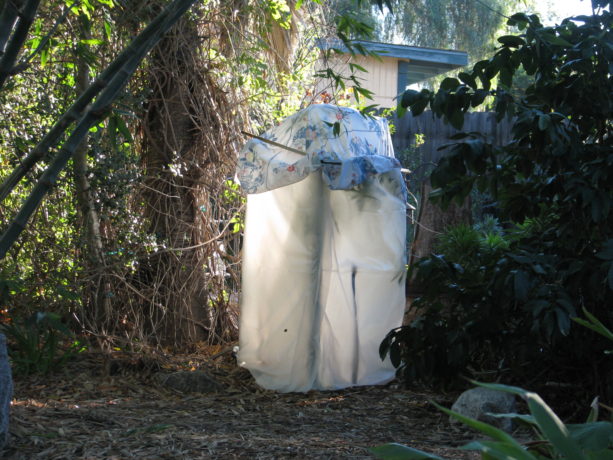 In areas such as here in flatland San Diego we don’t receive a lot of cold. We’re growing both tropicals which don’t want the frost, and stonefruit, brassicas and other plants that do better with a good chill. So when frost comes we need to manipulate it.
In areas such as here in flatland San Diego we don’t receive a lot of cold. We’re growing both tropicals which don’t want the frost, and stonefruit, brassicas and other plants that do better with a good chill. So when frost comes we need to manipulate it.Of course the best possible practice is to plant where there are optimal conditions for your particular types of plants and trees. Trees that need chilling should go down where frost settles. Tropicals should go higher where frost will roll past. However, circumstances change and you can’t be perfect all of the time, so here are some tips for helping your plants receive what they need:
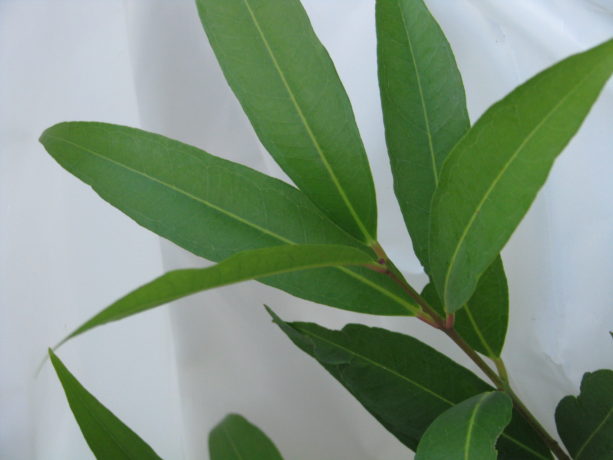 For young tropicals, some frost protection through the first winter is important. A very easy way to protect your trees is to set four stakes around the tree; the poles should be taller than the tree.
For young tropicals, some frost protection through the first winter is important. A very easy way to protect your trees is to set four stakes around the tree; the poles should be taller than the tree.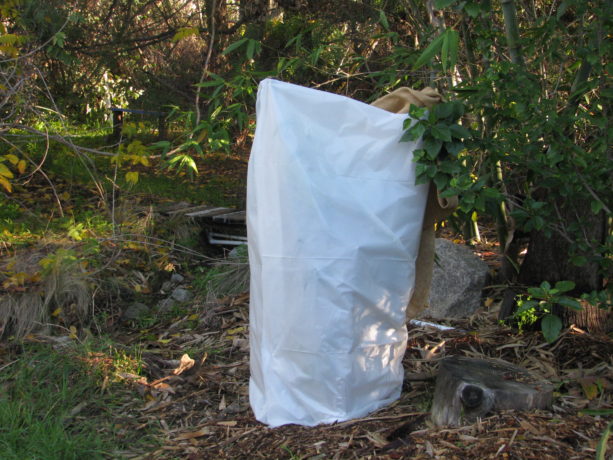 As much as I don’t like to use plastic, a 6 mil white plastic works best for this. Otherwise wrap in heavy burlap, blankets, etc. The thing about white plastic is that it lets in light so that you can set this up at the beginning of the cold season and leave it up until after the last frost. I open and close the top just on nights when it is going to be frosty.
As much as I don’t like to use plastic, a 6 mil white plastic works best for this. Otherwise wrap in heavy burlap, blankets, etc. The thing about white plastic is that it lets in light so that you can set this up at the beginning of the cold season and leave it up until after the last frost. I open and close the top just on nights when it is going to be frosty.Wrap the plastic around the poles, allowing some to be on the ground in a skirt which you can hold down with rocks, and some to extend above the top of the tree. Staple the plastic to the wooden poles. Frost rolls across the ground like water, so you want to make sure that it can’t roll under your plastic. It also comes down like water so you want to protect the top leaves. You can have a plastic flap that you can secure – tie down if its windy – over the top.
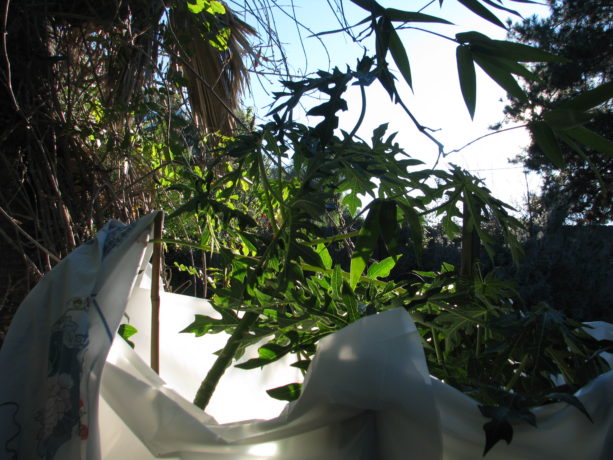 I used several layers of burlap on my mango and rose apple trees, and I’m using an old sheet on my papaya, as if that frosts at the top it will come back the next year, and I didn’t have poles tall enough to reach above the highest leaves. Burlap, particularly wet burlap, would be too heavy.
I used several layers of burlap on my mango and rose apple trees, and I’m using an old sheet on my papaya, as if that frosts at the top it will come back the next year, and I didn’t have poles tall enough to reach above the highest leaves. Burlap, particularly wet burlap, would be too heavy.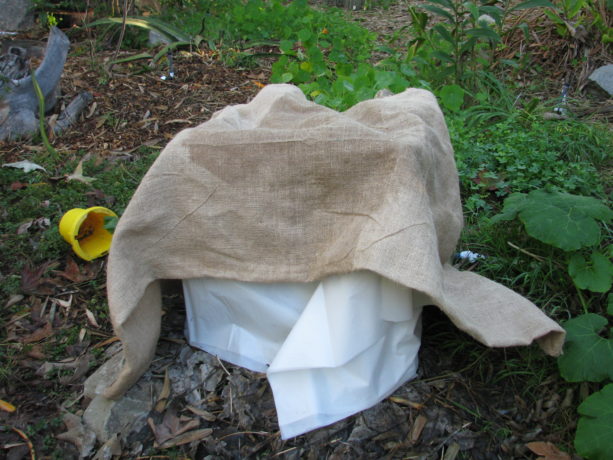
Be sure to uncover the tops of your plants in the morning so that they don’t cook. The plastic will act like a small greenhouse and help your plants keep cozy during cold days as well. This is a treat for a tomato that came up next to our mango and is enjoying the greenhouse effect.
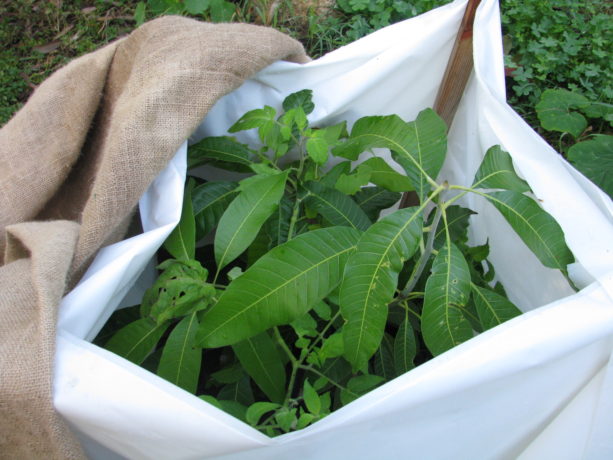
So what to do about capturing cold? Again, frost rolls downhill. Capturing it with obstacles such as earthen walls, stacked sandbags, bushes, railroad ties, or anything that keeps it from passing by will help deliver the chill hours needed. Be sure that the cold trap is created like a smile downhill of the plant; fishscale swales are in the same direction but placed above plants for water catchment. You want the cold to be caught in a cup.
This short video I took last week on Christmas day showed a very light frost, and how dramatically different it was between a path that had no obstacles, and the side that had.
https://youtu.be/1YgG7sTDfrA
After I shut the camera off I realized that I should also have wished you a Happy Hanukkah, an early Happy Kwanzaa, a general Happy Holiday for others, and now I wish you a Happy New Years, as we are five hours before the end of 2016.
Thanks for reading, thanks for doing permaculture and helping to save the planet. We can make the change we want to see happen.
